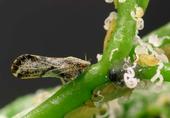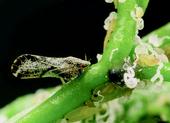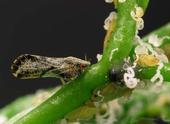
[From the Summer issue of the UC IPM Retail Nursery & Garden Center News]
The incurable citrus disease huanglongbing (HLB) has been detected in dozens of backyard trees in Los Angeles and Orange counties and most recently in Riverside. The bacterium that causes this disease is spread from tree to tree by Asian citrus psyllids (Figure 1). HLB, also known as citrus greening, has already devastated the citrus trees in Florida, Georgia, Louisiana, South Carolina, and Texas. There is no known treatment for the disease, which usually kills the tree within three to five...
- Author: Elizabeth E Grafton-Cardwell
- Author: Matthew Daugherty
- Author: Cheryl A. Wilen
![Figure 1. Highly magnified adult Asian citrus psyllid feeding on citrus. [B. Grafton-Cardwell]](https://ucanr.edu/blogs/UCIPMurbanpests/blogfiles/35982small.jpg)
[From the March 2016 issue of UC IPM's Retail Nursery & Garden Center IPM News]
Asian citrus psyllid (ACP) continues to spread and to be an ever-present concern in California. Because of this, we have updated information from the April 2015 issue of UC IPM's Retail IPM newsletter to share with your customers.
Until 2013, ACP was mostly found in Southern California, but has since been found in multiple locations in the Central Valley and has been detected as far north as the San Francisco Bay Area. The psyllid is well-established in coastal and inland Southern California and it is slowly establishing itself in...
- Author: Jeannette E. Warnert

From the UCANR Green Blog
A tell-tale sign of spring in California is a flush of new leaf growth on citrus trees. Because the feathery light green leaves are particularly attractive to Asian citrus psyllids (ACP), the leaves' emergence marks a critical time to determine whether the pest has infested trees.
“We encourage home citrus growers and farmers to go out with a magnifying glass or hand lens and look closely at the new growth,” said Beth Grafton-Cardwell, UC Agriculture and...
- Author: Elizabeth E Grafton-Cardwell
- Author: Cheryl A. Wilen
- Author: Matthew Daugherty

[From the April 2015 issue of the UC IPM Retail Newsletter]
In June 2013, we wrote about the Asian citrus psyllid (ACP) in UC IPM's Retail Nursery and Garden Center News. At that time, ACP was mostly found in parts of Southern California. It has since been detected in multiple locations in the Central Valley and has been detected in the San Francisco Bay Area. Thus, the psyllid is established near, or threatening much of, California's commercial, nursery, and residential...
- Author: Elizabeth E Grafton-Cardwell
- Author: Cheryl A. Wilen

[From the December 2014 issue of the UC IPM Green Bulletin]
In August 2012, we wrote about the Asian citrus psyllid (ACP) in UC IPM's Green Bulletin newsletter. At that time, ACP was found only in San Diego, Imperial, Riverside, San Bernardino, Los Angeles, and Orange counties. It has since been detected in Ventura, Santa Barbara, San Luis Obispo, Fresno, Kern, and Tulare counties, and in the last three months has been found in San Joaquin and Santa Clara counties (Figure...


